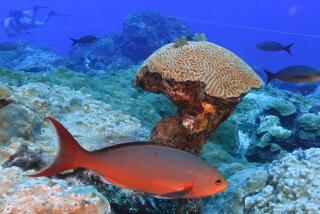Thaw between U.S. and Cuba extends to marine life with ‘sister sanctuary’ plans
Reporting from Washington — Florida’s depleted sea life is about to get a boost from an unlikely neighbor — Cuba.
Secretary of State John F. Kerry announced the emerging agreement while at an oceans conference in Chile last week and said he would go to Havana early next year to seal the deal.
The U.S. and Cuba, former Cold War adversaries, are establishing a “sister sanctuary” relationship between the Florida Keys National Marine Sanctuary and Guanahacabibes National Park, a protected area on the west coast of Cuba teeming with fish and healthy coral.
Scientists from each country will address common threats facing reefs. Americans will gain access to Cuba’s flourishing fish and their habitat. Cuban scientists will get a firsthand look at marine management in the Keys and restoration of the Everglades, a depleted ecosystem affected by urban sprawl and polluted runoff.
“Now you are seeing the two governments begin to collaborate in earnest in a way we just haven’t seen before. This is a real precedent-setting agreement,” said Daniel Whittle, director of the Environmental Defense Fund’s Cuba program, who met with officials and scientists from both countries.
He and other environmentalists hope the collaboration will help Cubans safeguard their pristine waters and marine life before the island is stressed by rapid economic development and a flood of tourists. Their success could have a direct impact on threatened fish populations in Florida.
“A lot of the species that commercial and recreational fishermen in Florida depend on — snappers and groupers especially — begin their life in Cuba,” Whittle noted. “The currents carry the larvae on ocean currents through the Florida Straits into southeast Florida. So by protecting the habitats in Cuba, you are helping to rebuild fish populations in the U.S.”
The agreement was formed during below-the-radar meetings in Dania Beach, Fla., in March and Havana in July. It grows out of larger diplomatic talks designed to draw the two nations closer together after half a century of alienation.
Officials from the U.S. State Department and the National Oceanic and Atmospheric Administration quietly hosted talks in March with their Cuban counterparts at Nova Southeastern University’s Oceanographic Center in Dania Beach.
“I think it’s a great deal,” said Richard Dodge, dean of oceanography at Nova Southeastern, who made a presentation on reef research to the group. “We’re so close. Our ecosystems are under a lot of stress. There may be ways to learn from each other how to manage our ecosystems.”
The collaboration builds on discussions between U.S. and Cuban leaders to establish joint contingency plans to contain damage in the event of an oil spill in Cuban waters.
Oil exploration off the Cuban coast has raised U.S. fears that a spill would produce a giant, toxic slick that could ride a powerful ocean current to Florida’s shores, fouling reefs, inlets and beaches.
Those fears faded when energy companies suspended the exploration, but Cuban leaders still hope to tap deposits believed to lie off the country’s north coast, within 50 miles of the Florida Keys.
The alarm over oil drilling raised awareness of the close environmental connections between Florida and Cuba. Birds fly, fish swim and ocean currents flow from the island to Florida and back, regardless of the U.S. trade embargo and conflicts between governments.
The sister sanctuary agreement extends to two offshore areas: the Flower Garden Banks, a national marine sanctuary in the Gulf of Mexico about 100 miles from the Texas coast; and Banco de San Antonio, a similar underwater area eight miles off the western tip of Cuba. More marine sanctuaries may be added to the agreement.
The Everglades, a “River of Grass” that flows into Florida Bay, is part of the discussion because of its similarity to Cuban ecosystems.
“Symbolically it’s an important trust-builder,” Whittle said. “The practical effect is that it will significantly increase the scientific capacity in Cuba in these areas. Professionals will conduct joint research, inventory marine life and habitat, identify species that migrate between the U.S. and Cuba and their nurseries.
“It shines a light on the fact that if Cuba protects its natural habitat and marine life, it’s a benefit to us in the U.S.”
More to Read
Sign up for Essential California
The most important California stories and recommendations in your inbox every morning.
You may occasionally receive promotional content from the Los Angeles Times.










